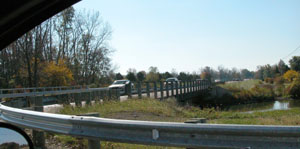By Shelley Grieshop
sgrieshop@dailystandard.com The Ohio Department of Transportation (ODOT) plans to slightly alter the roadway at the intersection of U.S. 127 and Coldwater Creek following a rash of serious injury accidents at the location.
 dailystandard.com"> dailystandard.com">
After a request one week ago by The Daily Standard to determine whether the view for motorists is adequate from the stop sign at Coldwater Creek, ODOT crews did a site distance and crash analysis of the intersection.
ODOT spokeswoman Barb Elliston said the white stop bar -- painted or embedded on the roadway at most intersections -- will be moved 21ò2 feet closer to U.S. 127 to allow motorists to yield closer to the busy highway. The white rectangular bar is the marked point where motorists are to yield before entering any intersection.
The work has not yet been scheduled, Elliston said.
"The engineers determined that moving the stop bar will greatly improve sight over the tall bridge rail," Elliston said. Bridge guardrails are located to the north and south of the intersection, which some motorists say are difficult to see over the top of when pulling onto U.S. 127 from Coldwater Creek Road. Elliston said the guardrails and posts are of standard size set by the state.
The most recent injury accidents at that particular intersection involved vehicles pulling onto U.S. 127 in front of southbound traffic -- the direction with the least visibility problem. Officials believe motorists entering from Coldwater Creek Road may be distracted while checking the more difficult-to-see northbound traffic.
The Daily Standard also questioned whether the downward slope from U.S. 127 onto the county road could be leveled to improve motorists' view. However, ODOT officials said the sloping did not contribute to the obstruction of view.
According to ODOT, there were seven accidents at the location from 2001-2003, but only two involved a driver who failed to yield to the highway traffic.
On Sept. 2 and Oct. 3, accidents at the intersection sent six people to area hospitals. Two Coldwater teens, Erin Pfaff, 18, and Olivia Meyers, 16, are still recovering from their injuries.
In 2003, ODOT doubled the amount of funding available to address high-crash locations from $35 to $65 million annually. However, they've found that about 90 percent of fatal crashes and 88 percent of injury crashes were classified as driver error including excessive speed, driver inattention and alcohol.
ODOT officials and county engineers believe the drop in traffic fatalities in Ohio the last few years is attributed to better engineering of the roadways, law enforcement and advancements in vehicle technology.
Auglaize County Engineer Doug Reinhart said highway engineers constantly evaluate area roadways, looking for problems and making changes as allowable by state regulations.
"Our highways, of course, are made to move people -- but safely," he added. |

